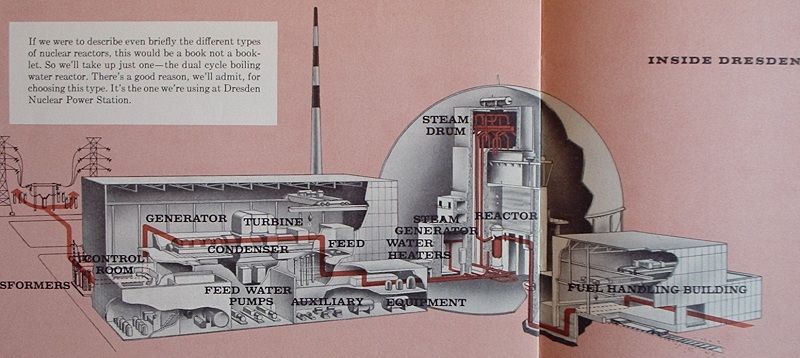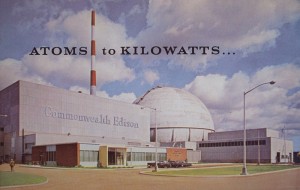Friday Matinee Special Feature: Atomic Venture
This week's ANS Nuclear Cafe "Friday Nuclear Matinee" is an extended special feature - a film entitled "Atomic Venture," produced in 1961 by General Electric Co., Commonwealth Edison and The Nuclear Power Group Inc. This movie runs about half an hour and is well worth watching, especially for those interested in the history of nuclear power in the United States.
DRESDEN NUCLEAR POWER STATION
Advertised quite widely as the first privately financed large nuclear power station anywhere, the plant that would become Dresden Unit 1 (when two others were later added) was actually ordered in 1955. Commonwealth Edison was to be the majority owner of the plant, and provided the land on which it was to be built - a site totaling 950 acres. The entire power plant was built under what today is called a "turn key" contract, in which the owner-operator signs a single contract with a vendor (in this case, General Electric) who covers or contracts out all EPC (Engineering, Procurement and Construction) responsibilities. Bechtel Corporation was contracted by GE to act as Architect-Engineer and as Constructor of the entire plant. The agreed fixed price was $45,000,000, with Commonwealth Edison paying $30,000,000 toward this total and spending another $6,000,000 outside the turnkey contract for site preparation and overhead costs. The Nuclear Power Group, which consisted of Commonwealth Edison and partners American Electric Power Service Corporation, Bechtel Corporation, Central Illinois Light Company, Illinois Power Company, Kansas City Power & Light Company, Pacific Gas & Electric Company and the Union Electric Company, paid the other $15,000,000 of the turnkey contract. Nuclear Power Group wrote off this expenditure as research and development. In the arrangements for constructing this plant, it was considered that the contribution of General Electric toward the project was the provision of a favorable contract price (according to contemporary materials) and the contract was provided with performance guarantees.
At the time this plant was under construction, it was hoped that the eventual actual operating cost of the plant (if the R&D cost was tossed out) would be about 3/4 cent per kilowatt-hour, which was right in line with what the most modern coal fired plants Commonwealth Edison had could do. This depended entirely, though, upon the plant being completed without having any cost overruns (which of course would be borne entirely by General Electric, thus having no impact on the owner-operator's economics but making the actual economy of the plant harder to figure out if not revealed by GE.) What's important about these figures is that economic operation of the plant was considered feasible even at such an early time in the history of nuclear energy.
Design work for the plant began March, 1956; preliminary site work began November 1956 (the date when temporary construction facilities were started) while the construction of the plant itself began in March 1957 with the start of excavation for the 190 foot diameter, spherical steel reactor enclosure and for the turbine building. The impressive steel sphere was complete and pressure tested March 27, 1958 and concrete pours to build the internal structures inside the sphere (to contain the reactor, steam generators, pumps, steam drum and other equipment) began just four days after this. The reactor was taken critical just over two years later, in October 1959. Full power was achieved after considerable startup and physics testing in June, 1960. The plant's behavior was judged as excellent, with good stability and also an ability to load follow daily on a 12-3-6-3 load cycle. (This means 12 hours at full power, 3 hours to ramp down power, 6 hours at 50% power, then another 3 hours to ramp back up to full power.)
Dresden 1 included a Nuclear Steam Supply System of a rather unusual "dual cycle" type, which included both the use of steam taken directly from the reactor (to drive the turbine) as well as four steam generators, which boiled water using heat taken from the water returning from the large single overhead steam drum. This design allowed for some temperature feedback to the reactor from the steam generators; this basically allowed the reactor to inherently respond to changes in power demand. This was one of only two applications of this design; a near duplicate of Dresden 1 was built shortly in Italy. The SENN project built a dual cycle reactor that was actually a very near twin of Dresden 1, initially rated 130 MWe but with provision to uprate to 230 MWe (and it also included a large spherical containment like Dresden 1.) This plant was also turnkey and was contracted to International General Electric Company through its European wholly owned subsidiary. (Dresden 1 was initially rated 626 MWt / 184 MWe; the turbine was initially rated for a maximum power output of 192 MWe but the plant actually later operated at 700 MWt / 207 MWe.)

Plant arrangement, Dresden Unit 1. From Commonwealth Edison brochure.
At the time Dresden was nearing completion, General Electric was in the middle of what it called "Operation Sunrise," which was a broad program investigating what approaches to reactor and power plant design would work best to facilitate an objective called "Target '65" -- which was the point (1965) that GE hoped nuclear power would be economically competitive with fossil fired power plants. To that end GE considered the First Generation plants to be Dresden as well as its earlier Vallecitos Boiling Water Reactor, along with the AEC's EBWR at Argonne National Lab and the BORAX and SPERT test reactors that had operated at NRTS Idaho. From this range of designs a wide set of data would be obtained (it was said) that would steer the design of the next generation of reactors, on whose shoulders then would stand the "economically competitive" plants that GE would have available as a menu in 1965.
A rather bewildering array of designs was planned, and to save time (and confusion) we'll let it suffice to say that only two were really built; the small size, natural circulation reactor was already under consideration by Pacific Gas & Electric and was eventually built as Humboldt Bay Unit 3, while the high power density concept was built as Big Rock Point.
General Electric essentially met the plans both for Dresden (as explained in the movie, the plant was on or just early in terms of schedule and on budget) and for Target '65. After 1963, GE began to receive orders "based solely on economics" and not for developmental work. Oyster Creek and Nine Mile Point, the first BWR/2 units (more modern reactor design with forced recirculation and internal steam separation) were ordered in 1963; the first units that "looked" design-wise like modern BWR's, the BWR/3 type, were first ordered in 1965 (the first actually being Dresden Unit 2.)
Dresden Unit 1 was very largely successful, although like all of the early nuclear plants, it did have some developmental problems that led to shutdowns and complications from time to time. The plant was shut down on October 31, 1978 to perform decontamination of piping and also to allow work to be performed to apply equipment backfits dictated by changes in regulatory standards. This shutdown was so extended that, while it was in progress, the Three Mile Island accident not only occurred (in March 1979) but also new regulations appeared that required even more equipment modification and backfitting. The cost to refit the unit was deemed excessive -- and Units 2 and 3 were operating right next door, developing far more power. Commonwealth Edison finally decided to retire Unit 1; it did perform a chemical cleaning in 1984 and then moved the unit to SAFSTOR (Safe Storage) condition, with actual decommissioning planned for the 2029 - 2031 time frame.
Dresden Nuclear Power Station, when completed, was the world's largest operating commercial nuclear power station. It kicked off a very extensive line of boiling water reactors, which were first sold and constructed worldwide by GE or its affiliates, and later were built by partners with GE such as Hitachi and Toshiba. Today the plant stands silent, although next to two fully operational units. ANS members had a chance to tour the site several years back; a fitting end to this piece is a link to the article that describes the experience.
---------------------------------------------------
Sources consulted for this article:
Atoms to Kilowatts - brochure by Commonwealth Edison, no date
Nucleonics, McGraw-Hill, May 1959 - GE advertisement "Target '65: Operation Sunrise"
Boiling Water Reactors. Andrew W. Kramer. Addison-Wesley Publishing Co. for the US Atomic Energy Commission, 1958.
The Atomic Energy Deskbook. John F. Hogerton. Reinhold Publishing, New York, 1963.
General Description of a Boiling Water Reactor, 16th printing. General Electric / Nuclear Energy Divisions May 1978.
The Nuclear Industry 1969. United States Atomic Energy Commission, 1969.
 Will Davis is Communications Director and board member for the N/S Savannah Association, Inc. He is a consultant to the Global America Business Institute, a contributing author for Fuel Cycle Week, and writes his own popular blog Atomic Power Review. Davis is also a consultant and writer for the American Nuclear Society, and serves on the ANS Communications Committee. He is a former US Navy reactor operator, qualified on S8G and S5W plants.
Will Davis is Communications Director and board member for the N/S Savannah Association, Inc. He is a consultant to the Global America Business Institute, a contributing author for Fuel Cycle Week, and writes his own popular blog Atomic Power Review. Davis is also a consultant and writer for the American Nuclear Society, and serves on the ANS Communications Committee. He is a former US Navy reactor operator, qualified on S8G and S5W plants.


